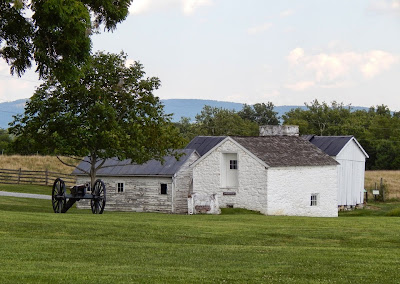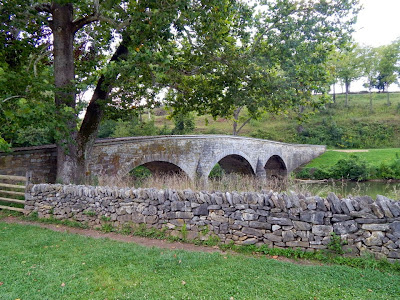Because part of my job as a mentor and man-builder is to educate the Spud, I took him to the National Battlefield at Antietam so he could learn about the day that 23,000 men, some his age or younger, were killed and wounded on this relatively small patch of Maryland farm country.
The cannon were beautiful, all original iron and bronze tubes on rebuilt carriages. And they're all over the park.
Here's a 10 pounder Parrott Rifle, a rifled piece that was state-of-the-art at the time. This one was made in 1864, too late for the Battle of Antietam, which took place in 1862.
Here's a 3-inch Ordnance Rifle, made in 1865.
And here we have an 1841 six-pounder gun that was a leftover from the Mexican War but still in use by the Confederates here during the battle. On the right is a Model 1857 twelve-pounder Howitzer, better known as a "Napoleon". Both of these guns were bronze tube smoothbores. They could throw some heavy loads, but not nearly as far or as accurately as the rifled guns.
Here's another bronze tube shown with it's full carriage that would have contained it's shot and powder and the tools needed to load, train and maintain the gun.
But I think what impressed the Spud about war--real war, as opposed to his video games--was when we were in the museum and he saw the surgeon's kit that contained little more than a big saw used for removing limbs. And of course there were battlefield implements like this one:
He got a bit quiet after I showed him that and made him read the tag.
Here's Spud and my mom at the Dunker Church, center of the Confederate line on the first day of the battle.
And the corn's about ready for harvest, much as it was on Miller's Farm as the Union troops moved up through it towards the church on September 17th back in 1862.
The cannon were waiting for them back then, and there's still plenty waiting there today.
A monument to just one of the many units that fought here. This one was the Union Army's Philadelphia Brigade from Pennsylvania. 545 lost on that morning, and a total loss of 3409 men between 1861 and 1865. And that was just one unit of one division of one army.
And here's the Lower Bridge over Antietam Creek, known today as Burnside Bridge after the vainglorious Union General who threw thousands of men against six hundred crack Georgia sharpshooters who were entrenched atop the ridge just beyond it. Before the bridge was taken, Antietam Creek ran red with blood clear to the Potomac, blood of countless young American men.Antietam Creek today, where it meets the Potomac. No longer red.
Antietam Battlefield is a beautiful place, and a somber place. Beneath it's fields and hills lie bullets and bits of cannon shot and bodies still undiscovered. Most of the dead were quickly buried where they fell and only after the war was over did anyone even begin to search for them and remove them to cemeteries for proper burial. The most recent one was found in 2008 and it's pretty much a given that there are still more out there, American men who never made it home from their sojourn into Maryland while wearing either blue or gray.





















A brilliant post Sir.
ReplyDeleteSomber is right... Thanks for the photos!
ReplyDeleteThe sheer courage of the men who fought those battles amazes me. Would our current population have the same grit and determination?
ReplyDeleteWell, there's a portion of the population that has demonstrated that grit and determination for the last 13 years anyhow.
DeleteThanks for the photos ML.
ReplyDeleteWalked that battlefield with Dad and Son. Very sobering experience. Should be required every 4 years on the 20th of January for the president to walk that battlefield and experience the results of screwing up their job.
ReplyDeleteSobering and thought-provoking post. Thank you.
ReplyDeleteLest We Forget
ReplyDeleteGreat post.
ReplyDeleteI've been to Gettysburg a few times, but never Antietam.